Mid-Watch in Verse: USS Detroit (CL-8)
This is a continuation of the Mid-Watch in Verse series. A Deck Log from a US Navy vessel chronicles exacting administrative detail regarding the status of the ship, its location, speed, etc. However, for a four hour period at the beginning of each year, the Officer of the Deck (OOD) is allowed to be creative by writing the Mid-Watch report (0000 – 0400) in verse if they choose to do so. This series highlights examples of this tradition and the officers who posted them. I focus on WWII era deck logs. For a more thorough history of the practice check out this article from the Naval History and Heritage Command.
Midwatch in Verse is now available as a book that features poems from 29 ships during WWII. See the book’s website for details.
USS Detroit was an Omaha-class light cruiser, commissioned 31 July 1923. During her early years, Detroit spent time on diplomatic missions in Europe, North Africa, and the Middle East. Often, she hosted heads of state and served as the flagship of cruiser divisions. In the early 1930s, Detroit moved to the Pacific fleet where she remained until the end of WWII.
On 7 December 1941, Detroit was moored in Pearl Harbor along with the USS Raleigh (CL-7), the USS Utah (BB-31/AG-16), and the USS Tangier (AV-8). While the attacking Japanese focused on Battleship Row on the other side of Ford Island, several torpedoes were dropped in the vicinity of the Detroit, missing her, but hitting the Raleigh and the Utah. The Raleigh suffered one torpedo hit, while the Utah took two torpedo hits and capsized. A Japanese Navy plane captured an image of the results of the attack.
Detroit managed to begin firing at the attacking aircraft with 3″ guns and 50 caliber machine guns (see the actual 7 December deck logs here and here). Members of the crew also used available firepower including rifles and pistols. The ship got underway at 10:10 a.m. and began patrolling outside the harbor. On 10 December 1941, at 11:25 a.m., Detroit reentered Pearl Harbor and moored to begin taking on ordinance and personnel.
In March of 1942, Detroit transferred approximately 20 metric tons of gold and silver from the USS Trout. Trout spirited the precious metals out of the Philippines in an attempt to keep them out of Japanese hands. Detroit brought the fortune to the US for safekeeping by the Department of the Treasury.
In late 1942, Detroit sailed from San Francisco to the Aleutians, where she remained until 1944. During her time in North Pacific waters, she assisted in preventing further Japanese incursions and participated in the liberation of the Aleutian Islands. After moving to the South Pacific, Detroit participated in several campaigns, including Iwo Jima and Okinawa invasions. She was one of only two ships present at Pearl Harbor on 7 December 1941 that also moored in Tokyo Harbor at the signing of the Japanese surrender in September 1945 (the other being the USS West Virginia). She earned 11 battle stars for her service during WWII.
Detroit was decommissioned at Philadelphia on 11 January 1946 and sold for scrap on 27 February.
This post contains three mid-watch entries written in verse. The three officers who posted them were assigned to the Detroit at the time of the Pearl Harbor attack. The first log was posted prior to the war in 1941. The second and third logs were posted in 1942 and 1944, respectively. Two of the officers who posted the logs were classmates at Annapolis in the class of 1940.
The first log is from 1 January 1941 and was written by Louis Adelard Perras. The original log can be seen here.
On the midnight deck of the DETROIT Maru
Stands the midwatch, lonely, cold and blue.
Still they are happy, joyous, gay,
For on the morrow they’ll not feel “that way.”
While from the galley are stealthy noises heard,
Proclaiming the QM poaching the festive bird.
In the bay, San Diego
‘Tis seven fathoms or so,
Moored bow to buoy number eighteen,
Stern to another, we stand in between
A stout eight inch manila preventer
With a one and an eighth inch wire,
Fast to our starboard anchor chain
Keep us from swinging on the blue Calif. Main.
There is steam in boiler number five,
Ah, It’s great to be alive!
Aboard on time, with a friendly wheeze,
Poorker, seaman second, returned from leave,
With neither a list nor a weave,
And nary a rating on his sleeve.
The NECHES, CUYAMA, AVOCET,
SOMERS, NESHO and PLATTE
Join ComAirScoFor* (the SOPA to you)
In wishing “Happy New Year” to Captain & crew.
Lo, at long, long last,
With various yard & district craft,
We end a weary four hours and a half.
L. A. Perras, Ensign, U.S. Navy.
Louis Adelard Perras Jr. was born 21 March 1917 in New Bedford, MA. Both of his parents were born in Quebec, Canada, and emigrated to the US. Louis’ father was a prominent physician in New Bedford. His mother, Marie Eugenie Josephine Banville, died only a month after his birth.
I’ve been unable to find much biographical information about Perras’ early life. He received an appointment to Annapolis and graduated in the class of 1940. During his time at the Naval Academy, he was known as an excellent tennis player. He maintained this interest throughout his life and held both national and New England rankings for his tennis prowess. His entry in the 1940 Annapolis yearbook, Lucky Bag, mentions his penchant for cussing in French, most likely was related to his parents’ French-Canadian background. A candid shot from the Lucky Bag also shows Perras playing tennis.
During his time in the Navy, Perras served on the USS New Mexico (BB-40) and the USS Gwin (DM-33) in addition to the Detroit. He rose to the rank of Lt. Cmdr. before leaving the Navy. In 1950, Perras graduated from the Boston College School of Law and spent many years in practice. He was well-known for his work as a trial attorney and did considerable pro bono work.
He died on 27 September 2004 at the age of 87. He was buried at Massachusetts National Cemetery in Bourne with Military Honors.
The next deck log verse was posted on 1 January 1942. The OOD posting the poem was Raymond John Schneider. The original log can be seen here.
The New Year came to Zone Plus Nine,
Without much celebration;
While a full moon shone o’re our convoy line,
The life-blood of the nation.
The longitude was one-three-eight,
The latitude three-five.
We poked along at a meagre rate
That was barely eight-point-five.
The steaming firerooms on the line
Were numbers Two and Four,
With number Three on a five minutes call
And One on Thirty more.
We steered a course of two-four-nine
In Task Force Fifteen-Two,
And raised white spray instead of wine
In toast to our comrades true.
So here’s to the future, to Forty Two,
And our great American nation;
To the men of the service in Navy blue,
Whatever their rank or station;
Let us look to the West where fiercest is raging,
The battle our fearless are dauntlessly waging.
To the work that’s ahead and the fight we’ve begun,
To a job that’s unfinished Until We Have Won!!
R. J. SCHNEIDER, Ensign, U.S. Navy
Raymond John Schneider was born 20 October 1917 in Cleveland, OH, to parents Raymond Michael and Marie Catherine. He received an appointment to the US Naval Academy at Annapolis in 1936. He graduated from Annapolis in the Class of 1940 and received his commission as an ensign. (Note: He was a classmate of Louis Perras mentioned above). Ensign Schneider’s first post was to the USS Detroit, where he served during the Japanese attack on Pearl Harbor (more on that below). His entry and an additional photo from the Lucky Bag can be found here and here.
According to a blog post by Schneider’s late son, Raymond, Jr., he left the Detroit in 1942 and pursued Navy flight training in Florida. After successful flight training and carrier qualification, Schneider held a variety of posts and furthered his engineering education including earning a master’s degree in aeronautical engineering from MIT in 1946. He rose through the ranks and in 1968 he received promotion to Rear Admiral. In 1972, he began his command of Naval Electronic Systems Command (NAVELEX) where he remained until his retirement in 1975. For excellence of service, Schneider received three Legion of Merit awards.
As an ensign on the Detroit on 7 December 1941, Schneider participated in the attempt to repel the Japanese attack on Pearl Harbor. In a 1981 article by Joe Nawrozki in the News American (Baltimore, MD), he recounted some of his experiences
I was supposed to have watch until 8 a.m., but about 6 a.m. I asked a bright, young ensign, who was clean and sober, if he’d finish my watch for me.[Editor’s note: This ensign was Charles L. Burbage, a 1941 Annapolis grad] He accepted and I went to my sack. The next thing I knew I heard this awful explosion, and I jumped up, still in my under wear. There was no time to dress. I ran up on deck and the entire area was being swarmed upon; the boat behind us was burning. I could see the Utah going upside down. The two airfields were full of flame and smoke. You got the impression all was not well.
I was in my Skivvies, barefoot, and the first thing I had to do was cut down the canvas awnings that were blocking the guns. I sent a sailor down to the butcher shop and we cut the canvas down with cutlery, but that cleared out nine antiaircraft guns. Someone blew the lock off the ammunition storage locker with a .45, the ammo came up, but we couldn’t find the fuse setters. Finally, we started the guns and we must have thrown a thousand shells into the air and didn’t hit a thing. I was chastised for being a little wasteful. But I’m convinced there never was a bombing of Honolulu, it was our antiaircraft fire.
The scene was such I was firing a rifle at the planes, still in my skivvies. Hardly a dramatic impression, but that’s the way it was. I stepped on a hot shell during the attack and ran to my room for my shoes. After that I went to bed, oh, six months with my shoes on. I didn’t want to go into combat again in my bare feet.
It’s very strange, the things that happen. There were two torpedoes fired at us, but they went in the mud. But they were headed for the forward area, where I was sleeping. If they would have hit, I would have been gone. Before we cast off, the gunnery officer told me I wasn’t wearing my tin hat. Now here I was, nothing but my underwear and shoes with a rifle, and he’s asking about my following regulations. We steamed out and chased Japs for a while. Later, I was on the thin edge of. the battle of Midway, then they sent me to Alaska.
I recently had the honor of “re-uniting” Schneider’s deck log verse with his children. They confirmed an observation that I had made prior to reading his Pearl Harbor recollections. He clearly had a great sense of humor. I recently read an address that Admiral Schneider gave at the Precise Time and Time Interval Planning Meeting in 1974, which began with the following: “Good morning ladies and gentlemen. I have a few prepared remarks. I intend to slightly embellish them with a few unprepared ones.” The talk contained many examples of a wry humor, but also with a deep understanding of topic at hand. He also challenged his audience to pursue ongoing efforts to improve our ability to measure increasingly small intervals of time to advance technological development. One of Admiral Schneider’s daughters told me in a personal communication that he did have a great sense of humor and frequently had those attending gatherings laughing heartily. She also told me that her father was an excellent pianist, learning how to play at the hand of his father who played the piano for silent movies and was the organist and choir director at St. James Roman Catholic Church in Cleveland. Schneider also played the organ at the Naval Academy. She also fondly recalled times when she was a child, sitting on a piano bench singing while her father played selections from operas.
Admiral Schneider was also, according to his daughter, a person who appreciated and lauded those individuals who toiled in obscurity: the common person. No job, no matter how menial it seemed to most individuals, was too small to go unappreciated.
Admiral Schneider died on 5 July 1985 and is buried at the Naval Academy Cemetery in Annapolis, MD.
The final mid-watch verse was posted on 1 January 1944 by Lt. Donald Charles Goodrich. The original can be seen here.
At Iliuliuk Bay in Berth B3
In 19 fathoms rode the Dashing “D”
With 90 of chain run out to port
We yawed and we swung with plenty of sport
CruDivOne**, DesRon*** forty-nine
Was a powerful force and not supine
ComDesRon in the SPROSTON sticks.
Commanding LUCE, ISHERWOOD, PICKING, PORTER and WICKES.
Condition “Y” and readiness III
Number Two’s on the line to give light to see
So out went the old and in came the new
And we stood and froze as we always do
And we’ll pray for a fight and the end of the War
As we usher in Nineteen – Forty Four
D. C. Goodrich, Lieut. USNR
Donald C. Goodrich was born to parents Roy Selah Goodrich and Ann Estelle Murray on 9 December 1915 in Arizona. His family was very well known in both Arizona and California. Roy Goodrich was a Harvard educated attorney who played a role in the process of the Arizona Territory becoming a state. His family, being rather wealthy, owned The Goodrich Building in downtown Phoenix for many years and enlisted well-known architect John Byers, to design a home for them in Bel-Air CA.
I had difficulty finding biographical information on Donald Goodrich. He attended The Thacher School in Ojai, CA, and The Milton Academy in Milton, Massachusetts, before enrolling at Harvard. During his time there, he majored in history, was a member of the Hasty Pudding Club, and expressed an interest in a career in business. Goodrich received his commission as an ensign in the Navy on 12 December 1940. His first posting was to the USS Detroit shortly after his commission.
He married Mary Frances Burkhard on 13 January 1942 in Honolulu, HI. His best man was Edward Laurence Doheny, III, of the famous California Doheny family who were prominent in the oil industry and owned the Greystone Mansion in Beverly Hills, CA.
Tracking Goodrich’s navy career has proved to be very difficult. I know that he was promoted to Lt(jg) on 15 June 1942, Lt on 1 March 1943, and LtCmdr. on 3 October 1945. He retired at that latter rank in January 1954.
At the time of the 1940 US Census, Goodrich was living in Los Angeles, CA, and listed his occupation as Real Estate Agent. I suspect that sometime during 1940 he attended Officer Training and was commissioned in December of that year. City directories show that Goodrich was in the real estate business from at least 1954 through 1970. Most of this time, he was affiliated with the R. A. Rowan Company, one of the oldest, long-lived real estate developers in the Los Angeles area.
Goodrich died on 13 June 1985 in San Diego, CA.
*COMAIRSCOFOR – Commander Air Forces Scouting Force
**CruDivOne – Cruiser Division One
***DesRon – Destroyer Squadron
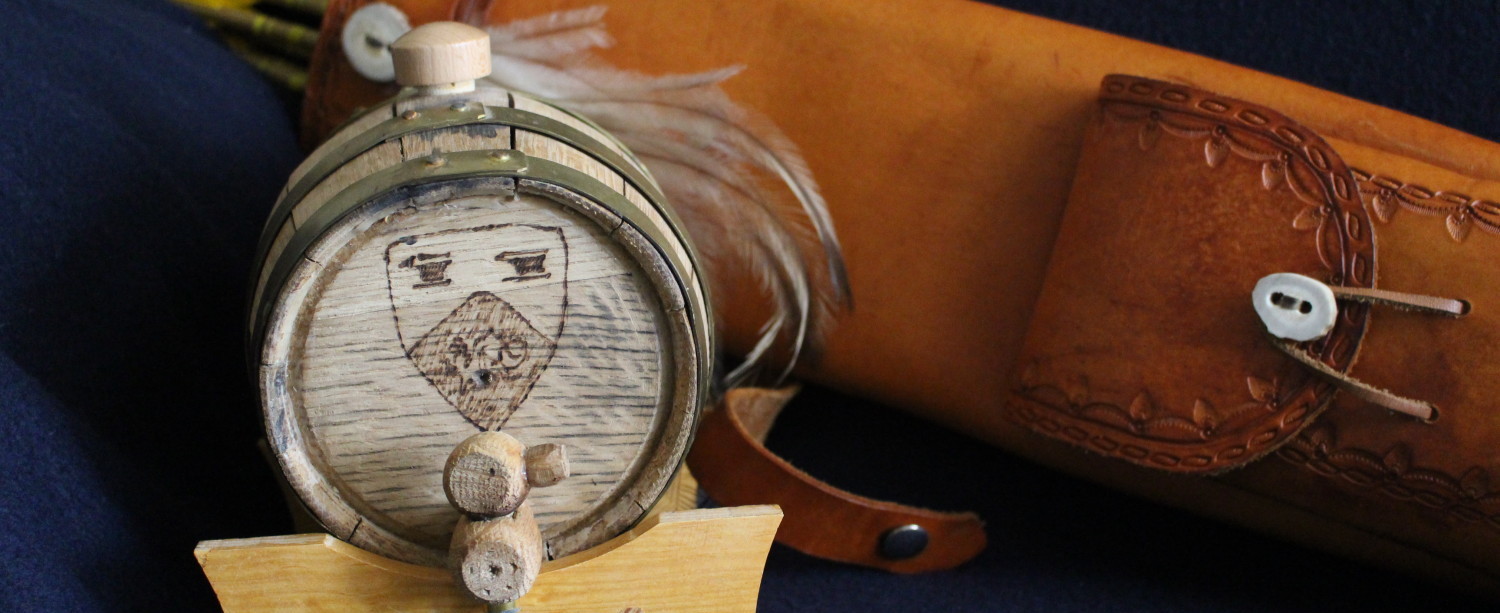
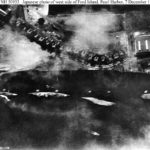
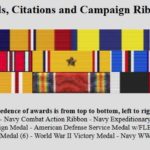
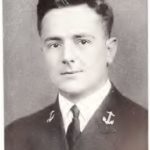
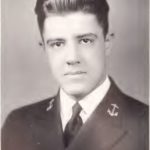
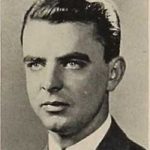
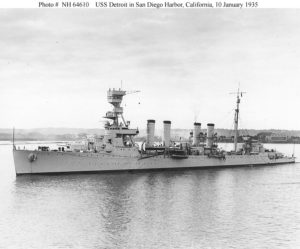
Comments
Mid-Watch in Verse: USS Detroit (CL-8) — No Comments
HTML tags allowed in your comment: <a href="" title=""> <abbr title=""> <acronym title=""> <b> <blockquote cite=""> <cite> <code> <del datetime=""> <em> <i> <q cite=""> <s> <strike> <strong>